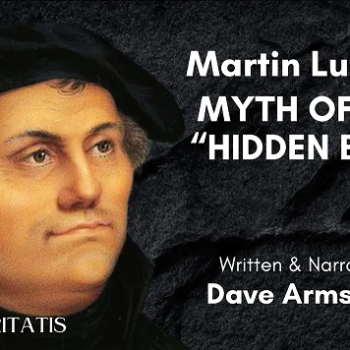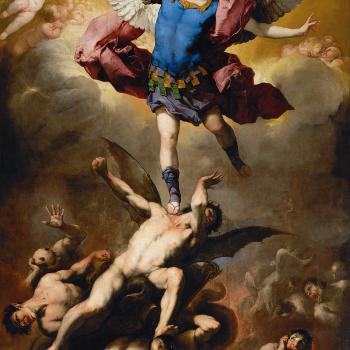
Atheist and anti-theist Bob Seidensticker runs the influential Cross Examined blog. He asked me there, on 8-11-18: “I’ve got 1000+ posts here attacking your worldview. You just going to let that stand? Or could you present a helpful new perspective that I’ve ignored on one or two of those posts?” He also made a general statement on 6-22-17: “In this blog, I’ve responded to many Christian arguments . . . Christians’ arguments are easy to refute.” He added in the combox: “If I’ve misunderstood the Christian position or Christian arguments, point that out. Show me where I’ve mischaracterized them.” I’m always one to oblige people’s wishes if I am able, so I decided to do a series of posts in reply.
It’s also been said, “be careful what you wish for.” If Bob responds to this post, and makes me aware of it, his reply will be added to the end along with my counter-reply. If you don’t see that at the end, rest assured that he either hasn’t replied, or didn’t inform me that he did. But don’t hold your breath. On 8-24-18 Bob wrote (after having virtually begged to dialogue with me back in May) that my alleged “disinterest in the truth reflects poorly” on me. What are we to make, then, of his utter “disinterest” in defending his opinions against serious critique?
Bob’s words will be in blue. To find these posts, word-search “Seidensticker” on my atheist page or in my sidebar search (near the top).
*****
Bob (always a sloppy, incoherent thinker when he starts to analyze the Bible) outdoes himself in his article: “Contradictions in the Resurrection Account” (10-17-11; rev. 4-17-14). I’ve written about how the vast majority of what atheists claim are “contradictions” in the Bible actually aren’t at all: they fail the simple test of logic applied to them (how ironic, huh?). See:
Review of The Book of Non-Contradiction (Phillip Campbell)
Alleged “Bible Contradictions”: Most Are Actually Not So
That’s the case in this instance, as will be readily seen in many examples.
The different accounts of the resurrection are full of contradictions . . .
The issues listed above sure sound like contradictions to me, . . .
What were the last words of Jesus? Three gospels give three different versions.
Matthew 27:46, 50 (RSV, as throughout, when I cite Scripture)) And about the ninth hour Jesus cried with a loud voice, “Eli, Eli, la’ma sabach-tha’ni?” that is, “My God, my God, why hast thou forsaken me?” . . . [50] And Jesus cried again with a loud voice and yielded up his spirit.
Verse 50 indicates that Jesus said something else before He died, but doesn’t record what He said. But as to the last words that it records Him saying, we know they weren’t His last, according to Matthew. Therefore, The Gospel of Matthew doesn’t claim to give a record of Jesus’ last words. This is precisely the case in the Gospel of Mark as well:
Mark 15:34, 37 And at the ninth hour Jesus cried with a loud voice, “E’lo-i, E’lo-i, la’ma sabach-tha’ni?” which means, “My God, my God, why hast thou forsaken me?” [37] And Jesus uttered a loud cry, and breathed his last.
Luke 23:46 Then Jesus, crying with a loud voice, said, “Father, into thy hands I commit my spirit!” And having said this he breathed his last.
The Gospel of Luke does claim to record Jesus’ last words, and is perfectly consistent with Matthew and Mark: both of which do not claim to do so. They say He made a loud cry and then “yielded up his spirit” / “breathed his last” but don’t inform us what He said. Luke does (concurring that He said these words “crying with a loud voice”). Anyone who sees a logical contradiction here would surely have failed an introductory logic class (or would be laughed out of it: one or the other).
John 19:30 When Jesus had received the vinegar, he said, “It is finished”; and he bowed his head and gave up his spirit.
This easily synthesizes with Luke 23:46, interpreted as what He said right before saying, “Father, into thy hands I commit my spirit!”, since the three synoptic Gospels (considered together) refer to this saying as a loud cry, following which He “breathed his last” (Mark / Luke) or “yielded up his spirit” (Matthew): which is he same as John’s “gave up his spirit.”
Thus there are not three contradictory versions of Jesus’ last words; there are four harmonious versions: only one of which (Luke) actually asserts a precise chronology of “He said x, and then immediately died.” Because of that, the reasonable take is that Luke records Jesus’ last words. The other accounts are perfectly consistent with Luke (recording words that He stated before His last words). Bob thinks otherwise, and sees “contradictions.” But Bob is out to sea (as so often).
When Jesus died, did an earthquake open the graves of many people, who walked around Jerusalem and were seen by many? Only Matthew reports this remarkable event. It’s hard to imagine any reliable version of the story omitting this zombie apocalypse.
So what? Absence of some event in other alternate accounts is simply not a logical contradiction. The notion that the Gospels beside Matthew ought to have included it is simply Bob’s arbitrary opinion. It’s no “argument” that compels anyone to accept his “reasoning.” There is no “law” that requires four biographical accounts to include the exact same events and to have no differences at all from each other. It’s just the usual irrational skepticism of the nonbeliever or theological liberal. And these sorts of pseudo-“arguments” are embarrassingly silly.
They can’t even agree on whether Jesus was crucified on the day before Passover (John) or the day after (the other gospels).
See three good explanations of the seeming discrepancy (one / two / three).
Who buried Jesus? Matthew says that it was Joseph of Arimathea. No, apparently it was the Jews and their rulers, all strangers to Jesus (Acts).
See a good explanation at The Domain for Truth website.
How many women came to the tomb Easter morning? Was it one, as told in John? Two (Matthew)? Three (Mark)? Or more (Luke)? . . . How many women were at the tomb? Obviously, five or more, our apologist will say. When John only says that Mary Magdalene came to the tomb, he’s not saying that others didn’t come, right?
The RationalChristianity.Net site states:
How many women visited the tomb? (Matthew 28:1, Mark 16:1, Luke 24:10, John 20:1)
Putting Mark 16:1 and Luke 24:10 together, at least five women visited the tomb, four of whom were Mary Magdalene, Mary the mother of James, Salome and Joanna. While John’s account only refers to Mary Magdalene, it implies other women went with her to the tomb, since Mary’s words to Peter and John are, “We don’t know where they have put him!” (Jn 20:2). Some possible harmonizations of the visit to the tomb have all the women arriving together; other harmonizations have multiple groups of women going to the tomb at different times.
J. P. Holding points out that no contradiction is entailed: “No one list excludes any other; none speaks of these being the only persons to travel to the tomb.” The Thomistic Bent site adds:
[W]hen we have three gospel writers listing both Marys, and one just mentioning one Mary, there is no problem at all. When Dr. Luke mentions “the other women” but does not give their name, we do not fault him, for this is a normal way of telling a story. John’s way of just mentioning only Mary Magdalene would be very routine, especially if Mary Magdalene had become a prominent leader in the church.
There is no contradiction, or even difficulty, in the number of women who appear at the tomb on resurrection morning. Trying to make an issue out of this only appears to be a skeptic in search of a controversy, determined to find one.
Did an angel cause a great earthquake that rolled back the stone in front of the tomb? Yes, according to Matthew. The other gospels are silent on this extraordinary detail.
Again, silence of three Gospels on an incident that one mentions is not a contradiction. Why anyone would think it was is the only mystery or “problem” here. It appears, though, that Matthew is a more detailed Gospel, since it alone mentioned the incident of the people coming out of their graves (mentioned above), too.
The only way this silence could be “contradictory” is if one accepted the folloing unproven premise beforehand: “all four Gospels must include every notable event that any one of them mentions.” This is, of course, non-compelling. I see no rational basis upon which to require such a premise. Atheists who think like this are being equal parts irrational, silly, and arbitrary.
Who did the women see at the tomb? One person (Matthew and Mark) or two (Luke and John)?
The late Presbyterian Bible scholar R. C. Sproul gives a good refutation of this supposed “contradiction”:
Matthew 28:1–10 and Mark 16:1–8 say there was one angel at the empty tomb, while Luke 24:1–12 mentions the presence of two angels at Jesus’ grave. That was one of the “contradictions” my friend brought to me. So I said we should assume for the sake of argument that two angels were present. If so, would it not be possible for one eyewitness to be more concerned about who wasn’t there—Jesus—than he was about the number of angels present, especially if one of them did not speak? The disciple could have said, “I went there, and I saw an angel, who said x, y, and z,” without mentioning the second angel because the presence of two angels wasn’t that significant to the disciple who was writing. I asked my friend, “What word is conspicuously absent from this disciple’s report that must be there to have a true contradiction?” The answer was clear: the word only. If there were two angels, we know there had to be at least one; thus, since Mark and Matthew don’t say there was only one angel there, there’s no contradiction between them and Luke. Instead, there’s variation in perspectives because they’re relying on different eyewitness reports of the same event. Such variation is exactly what we should expect from independent accounts.
Was the tomb already open when they got there? Matthew says no; the other three say yes.
Once again, it’s simply not a formal logical contradiction. It gets tiring having to point this out over and over. One is tempted to shout: “For the love of sanity, go take a course in logic!” The reply to this is simple, and Peter Ballard provides it (citing skeptic Dan Barker in italics):
Was the tomb open when they arrived?
- Matthew: No (28:2)
- Mark: Yes (16:4)
- Luke: Yes (24:2)
- John: Yes (20:1)
Answer: Yes. While Matthew describes the opening of the tomb, he does not say that the women witnessed it.
Did the women tell the disciples? Matthew and Luke make clear that they did so immediately. But Mark [16:8] says, “Trembling and bewildered, the women went out and fled from the tomb. They said nothing to anyone, because they were afraid.”
1) The last clause gives no indication of how long they “said nothing.” It may not have been very long at all. We can only guess or speculate.
2) “Said nothing” with no indication of how long the silence was, is not the same thing as saying that they never mentioned it to anyone, ever.
Technically, Matthew doesn’t declare that they “immediately” told the disciples: “they departed quickly from the tomb with fear and great joy, and ran to tell his disciples” (28:8). This describes intention as opposed to a fact of having told the disciples (let alone “immediately”). Therefore, a gap in time is possible that is harmonious with the data of Mark 16:8. Likewise, Luke 24:10 that they “told this to the apostles” with no indication that it was “immediate.” Thus, no undeniable contradiction can be asserted.
Did Mary Magdalene cry at the tomb? That makes sense—the tomb was empty and Jesus’s body was gone. At least, that’s the story according to John. But wait a minute—in Matthew’s account, the women were “filled with joy.”
This is really asinine, and is about the limit of patience that any fair-minded / rational / objective human being can take. Mary cried before she knew that Jesus was risen (thinking that someone stole the body: John 20:11-13, 15). In Matthew, the women had “great joy” because it was after the angel told them that Jesus was risen (28:5-8).
Can anyone on the face of the earth explain to me how this is a “contradiction”? Nonsense like this is an insult to everyone’s intelligence (and that should include non-polemical atheists who don’t despise Christianity and Christians, and who seek to be rational, sensible, and fair).
Did Mary Magdalene recognize Jesus? Of course! She’d known him for years. At least, Matthew says that she did. But John makes clear that she didn’t. [Jn 20:14-15]
John also makes it clear that it was “early, while it was still dark” (20:1). So now Mary Magdalene had some of those night vision glasses? I guess so . . . It’s as if no one ever misidentified someone in the pitch dark. Duh!!!! The same “dark” scenario is described in 21:4: “Just as day was breaking, Jesus stood on the beach; yet the disciples did not know that it was Jesus.”
Could Jesus’s followers touch him? John says no; the other gospels say yes.
Peter Ballard offers the quick refutation (again, citing Dan Barker):
Could Jesus be touched after the resurrection?
- Matthew: Yes (28:9)
- John: No (20:17), Yes (20:27)
Answer: Yes. John 20:17 [RSV: “do not hold me”] is literally “stop touching me”, so obviously he could be touched.
Linguist A. T. Robertson, in his Word Pictures of the New Testament explains the precise Greek sense:
Touch me not (mh mou aptou). Present middle imperative in prohibition with genitive case, meaning “cease clinging to me” rather than “Do not touch me.” Jesus allowed the women to take hold of his feet (ekrathsan) and worship (prosekunhsan) as we read in Matthew 28:9 . The prohibition here reminds Mary that the previous personal fellowship by sight, sound, and touch no longer exists and that the final state of glory was not yet begun. Jesus checks Mary’s impulsive eagerness. For I am not yet ascended (oupw gar anabebhka). Perfect active indicative.
Since Jesus was prohibiting prolonged touching, rather than all touching, the alleged contradiction vanishes. Several well-known Bible translations make this meaning more immediately obvious:
NIV / NRSV / Good News: “Do not hold on to me”
NASB: “Stop clinging to Me”
J. B. Phillips: “do not hold me now”
NAB (revised): “Stop holding on to me”
Jerusalem / NEB / REB / Amplified / NKJV: “Do not cling to me”
Where did Jesus tell the disciples to meet him? In Galilee (Matthew and Mark) or Jerusalem (Luke and Acts)?
For a quite sufficient explanation, see the article, “To Galilee or Jerusalem?” by Eric Lyons, at the excellent Apologetics Press website. Here is the heart of his argument:
The truth is, Jesus met with His disciples in both places, but He did so at different times. One of the reasons so many people allege that two or more Bible passages are contradictory is because they fail to recognize that mere differences do not necessitate a contradiction. For there to be a bona fide contradiction, not only must one be referring to the same person, place, or thing in the same sense, but the same time period must be under consideration. . . .
Similarly, Jesus met with His disciples both in Jerusalem and in Galilee, but at different times. On the day of His resurrection, He met with all of the apostles (except Thomas) in Jerusalem just as both Luke and John recorded (Luke 24:33-43; John 20:19-25). Since Jesus was on the Earth for only forty days following His resurrection (cf. Acts 1:3), sometime between this meeting with His apostles in Jerusalem and His ascension more than five weeks later, Jesus met with seven of His disciples at the Sea of Tiberias in Galilee (John 21:1-14), and later with all eleven of the apostles on a mountain in Galilee that Jesus earlier had appointed for them (Matthew 28:16). Sometime following these meetings in Galilee, Jesus and His disciples traveled back to Judea, where He ascended into heaven from the Mount of Olives near Bethany (Luke 24:50-53; Acts 1:9-12).
None of the accounts of Jesus’ post-resurrection appearances contradicts another. Rather, each writer supplemented what a different writer left out. . . .
Still, one may ask, “Why did Jesus command His apostles to ‘tarry in the city of Jerusalem’ on the day of His resurrection until they were ‘endued with power from on high’ (Luke 24:49), if He really wanted them to meet Him in Galilee?” Actually, it is an assumption to assert that Jesus made the above statement on the same day that He arose from the grave. One thing we must keep in mind as we study the Bible is that it normally is not as concerned about chronology as modern-day writings. Frequently (especially in the gospel accounts), writers went from one subject to the next without giving the actual time or the exact order in which something was done or taught (cf. Luke 4:1-3; Matthew 4:1-11). In Luke 24, the writer omitted the post-resurrection appearances of Jesus in Galilee (mentioned by both Matthew and John). However, notice that he never stated that Jesus remained only in Jerusalem from the day He rose from the grave until the day He ascended up into heaven.
Should the gospel be preached to everyone? In Matthew 28:19, Jesus says to “teach all nations.” But hold on—in the same book he says, “Do not go among the Gentiles or enter any town of the Samaritans” (Matt. 10:5). Which is it?
Absolutely ridiculous . . . Jesus made it clear on many occasions that He came (first in order of priority) as the Messiah of Israel (Mt 15:24; cf. 23:37). This is what “Christ” means (Greek for “Messiah”). But eventually the Gospel was to preached also to the Gentiles (as Acts highlights, in describing the actions of St. Peter and St. Paul with the Gentiles; thus, Jesus indicates what is coming in Mt 28:19). Paul expressed this broader emphasis in a slightly different way in this passage:
Acts 18:5-6 When Silas and Timothy arrived from Macedo’nia, Paul was occupied with preaching, testifying to the Jews that the Christ was Jesus. [6] And when they opposed and reviled him, he shook out his garments and said to them, “Your blood be upon your heads! I am innocent. From now on I will go to the Gentiles.”
At the time of Matthew 10 Jesus and His disciples were still concentrated on the first (more specific and exclusive) task, as indicated by the next verse: “go rather to the lost sheep of the house of Israel.” How in the world is this a contradiction? It would be like saying, “go proclaim the gospel to your relatives and neighbors.” Then after a period of time, the target audience is expanded: “go proclaim the gospel to everyone.”
Who saw Jesus resurrected? Paul says that a group of over 500 people saw him (1 Cor. 15:6). Sounds like crucial evidence, but why don’t any of the gospels record it? . . . Why didn’t all the gospels note that a group of 500 people saw Jesus (instead of only Paul)?
I don’t know, but it’s not a contradiction: as explained twice above in other instances of one report only.
Was the tomb already open or not? Did Mary Magdalene recognize Jesus or not? Did Jesus remain for 40 days or not? Should the gospel be preached to everyone or not? Did the women tell the disciples or not? Was Jesus crucified the day after Passover or not? Who knows what he’ll come up with, but our apologist will have some sort of harmonization for these, too.
Yep, the ol’ kindergarten try.
You, the reader (like a jury member) must now decide who provided a more rational, sensible, plausible case: Bob Seidensticker with his never-ending litany of alleged biblical “contradictions” or myself. I have every confidence that any fair-minded person whose mind isn’t already made up on all these “issues” will observe the severe shortcomings of Bob’s relentless biblical skepticism. Being too agenda-driven (in this instance: “the Bible is massively self-contradictory because it’s not inspired”) leads one to the foolish inanities that we see from Bob above. He himself is much smarter than this, and should know better. But excessive bias (up to and including downright hostility) is always the enemy of rational and objective thinking.
***
For related further very in-depth reading, see: “Do the Resurrection accounts HOPELESSLY contradict one another?” by Glenn Miller (Christian Thinktank).
***
Photo credit: image by slightly_different (8-31-16) [Pixabay / CC0 Creative Commons license]
***













